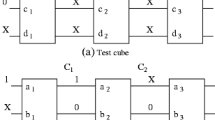Abstract
At-speed scan testing, based on ATPG and ATE, is indispensable to guarantee timing-related test quality in the DSM era. However, at-speed scan testing may incur yield loss due to excessive IR-drop caused by high test (shift & capture) switching activity. This paper discusses the mechanism of circuit malfunction due to IR-drop, and summarizes general approaches to reducing switching activity, by which highlights the problem of current solutions, i.e. only reducing switching activity for one capture while the widely used at-speed scan testing based on the launch-off-capture scheme uses two captures. This paper then proposes a novel X-filling method, called double-capture (DC) X-filling, for generating test vectors with low and balanced capture switching activity for two captures. Applicable to dynamic & static compaction in any ATPG system, DC X-filling can reduce IR-drop, and thus yield loss, without any circuit/clock modification, timing/circuit overhead, fault coverage loss, and additional design effort.














Similar content being viewed by others
References
Bushnell ML, Agrawal VD (2000) Essentials of electronic testing for digital, memory & mixed-signal VLSI circuits. Kluwer Academic Publishers, New York
Butler KM, Saxena J, Fryars T, Hetherington G, Jain A, Levis J (2004) Minimizing power consumption in scan testing: pattern generation and DFT techniques. In: Proceedings of IEEE international test conference, Charlotte, October 26–28, pp 355–364
Chandra A, Chakrabarty K (2002) Reduction of SoC test data volume, scan power and testing time using alternating run-length codes. In: Proceedings of design automation conference, New Orleans, June, pp 673–678
Corno F, Prinetto P, Redaudengo M, Reorda M (1998) A test pattern generation methodology for low power consumption. In: Proceedings of VLSI test symposium, Montreal, April, pp 35–40
Corno F, Prinetto P, Redaudengo M, Reorda M (2000) A test pattern generation methodology for low power consumption. In: Proceedings of VLSI test symposium, Montreal, May, pp 35–40
El-Maleh AH, Al-Utaibi K (2004) An efficient test relaxation technique for synchronous sequential circuits. IEEE Trans on Comput-Aided Des 23(6):933–940
Girard P (2002) Survey of low-power testing of VLSI circuits. IEEE Des Test Comput 19(3):82–92
Kokrady A, Ravikumar CP (2004) Fast, layout-aware validation of test vectors for nanometer-related timing failures. In: Proceedings of international conference on VLSI design, Mumbai, January, pp 597–602
Lee K, Huang T, Chen J (2000) Peak-power reduction for multiple-scan circuits during test application. In: Proceedings of Asian test symposium, Taipei, December, pp 435–440
Li W, Reddy SM, Pomeranz I (2005) On reducing peak current and power during test. In: Proceedings of IEEE computer society annual symposium on VLSI, Tampa, May, pp 156–161
Lin X, Press R, Rajski J, Reuter P, Rinderknecht T, Swanson B, Tamarapalli N (2003) High-frequency, at-speed scan testing. IEEE Des Test Comput: 17–25, September–October
Mitra S, Volkerink E, McCluskey E, Eichenberger S (2004) Delay defect screening using process monitor structures. In: Proceedings of VLSI Test Symposium, Napa Valley, May, pp 43–52
Miyase K, Kajihara S (2004) XID: don’t care identification of test patterns for combinational circuits. IEEE Trans Comput-Aided Des Integr Circuits Syst 23(2):321–326
Nicolici N, Al-Hashimi B (2003) Power-constrained testing of VLSI circuits. Kluwer Academic Publishers
Nourani M, Tehranipoor M, Ahmed N (2005) Pattern generation and estimation for power supply noise analysis. In: Proceedings of VLSI Test Symposium, Palm Springs, May, pp 439–444
Remersaro S, Lin X, Zhang Z, Reddy SM, Pomeranz I, Rajski J (2006) Preferred fill: a scalable method to reduce capture power for scan based designs. In: Proceedings of the international test conference, Santa Clara, October, Paper 32.2
Sankaralingam R, Oruganti R, Touba N (2000) Static compaction techniques to control scan vector power dissipation. In: Proceedings of VLSI Test Symposium, Montreal, May, pp 35–40
Saxena J, Butler KM, Jayaram VB, Kundu S (2003) A case study of IR-drop in structured at-speed testing. In: Proceedings of international test conference, Charlotte, September, pp 1098–1104
Wang S, Wei W (2007) A technique to reduce peak current and average power dissipation in scan designs by limited capture. In: Proceedings of Asian South Pacific design automation conference, Yokohama, January, pp 810–816
Wang J, Walker DMH, Majhi A, Kruseman B, Gronthoud G, Villagra LE, Wiel P, Eichenberger S (2006) Power supply noise in delay testing. In: Proceedings of the international test conference, Santa Clara, October, Paper 17.3
Wang L-T, Wu C-W, Wen X (eds) (2006) VLSI Test Principles and Architectures: Design for Testability. Elsevier
Wen X, Yamashita Y, Morishima S, Kajihara S, Wang L-T, Saluja KK, Kinoshita K (2005) Low-capture-power test generation for scan-based at-speed testing. In: Proceedings of the international test conference, Austin, October, Paper 39-2
Wen X, Yamashita Y, Morishima S, Kajiihara S, Wang L-T, Saluja KK, Kinoshita K (2005) On low-capture-power test generation for scan testing. In: Proceedings of the VLSI test symposium, Palm Springs, May, pp 265–270
Wen X, Kajihara S, Miyase K, Suzuki T, Saluja KK, Wang L-T, Abdel-Hafez KS, Kinoshita K (2006) A new ATPG method for efficient capture power reduction during scan testing. In: Proceedings of the VLSI test symposium, Berkeley, May, pp 58–63
Wen X, Miyase K, Suzuki T, Yamato Y, Kajihara S, Wang L-T, Saluja KK (2006) A highly-guided X-filling method for effective low-capture-power scan test generation. In: Proceedings of the international conference on computer design, San Jose, October, pp 251–258
Yoshida T, Watari M (2003) MD-scan method for low power scan testing. In: Proceedings of the international test conference, Charlotte, September, pp 480–487
Author information
Authors and Affiliations
Corresponding author
Additional information
Responsible Editor: N. Nicolici
Rights and permissions
About this article
Cite this article
Wen, X., Miyase, K., Suzuki, T. et al. Low Capture Switching Activity Test Generation for Reducing IR-Drop in At-Speed Scan Testing. J Electron Test 24, 379–391 (2008). https://doi.org/10.1007/s10836-007-5033-3
Received:
Accepted:
Published:
Issue Date:
DOI: https://doi.org/10.1007/s10836-007-5033-3




